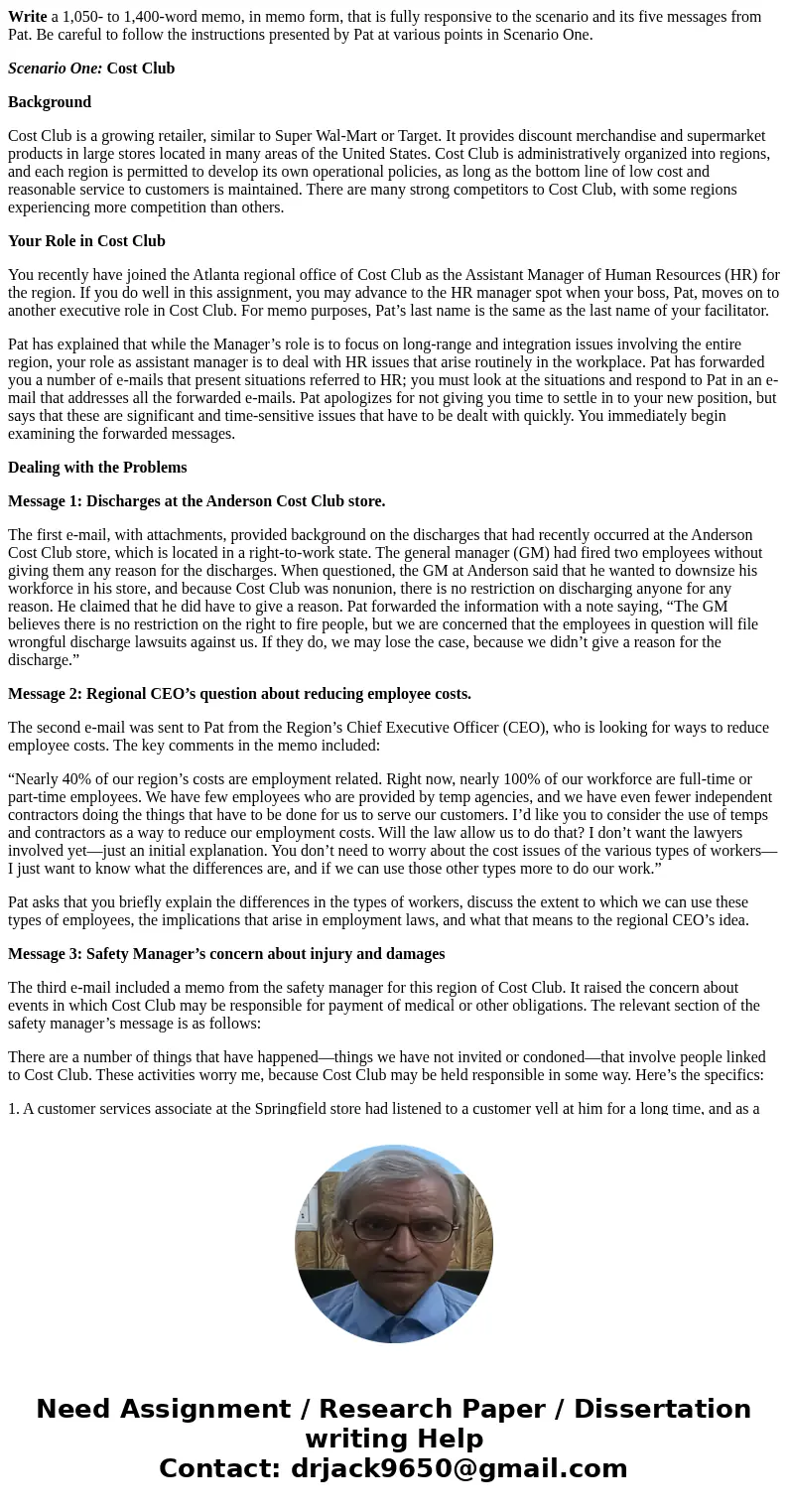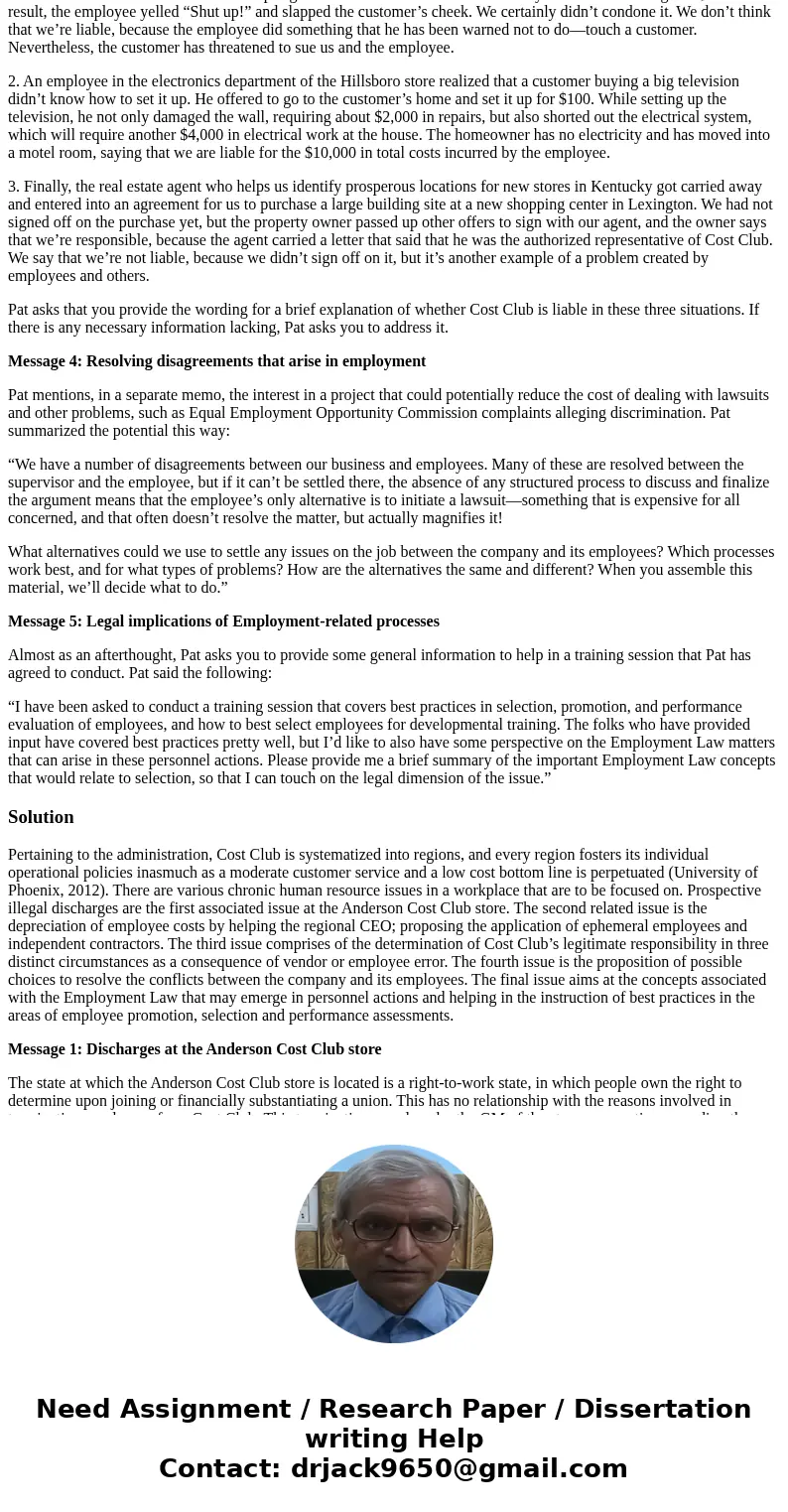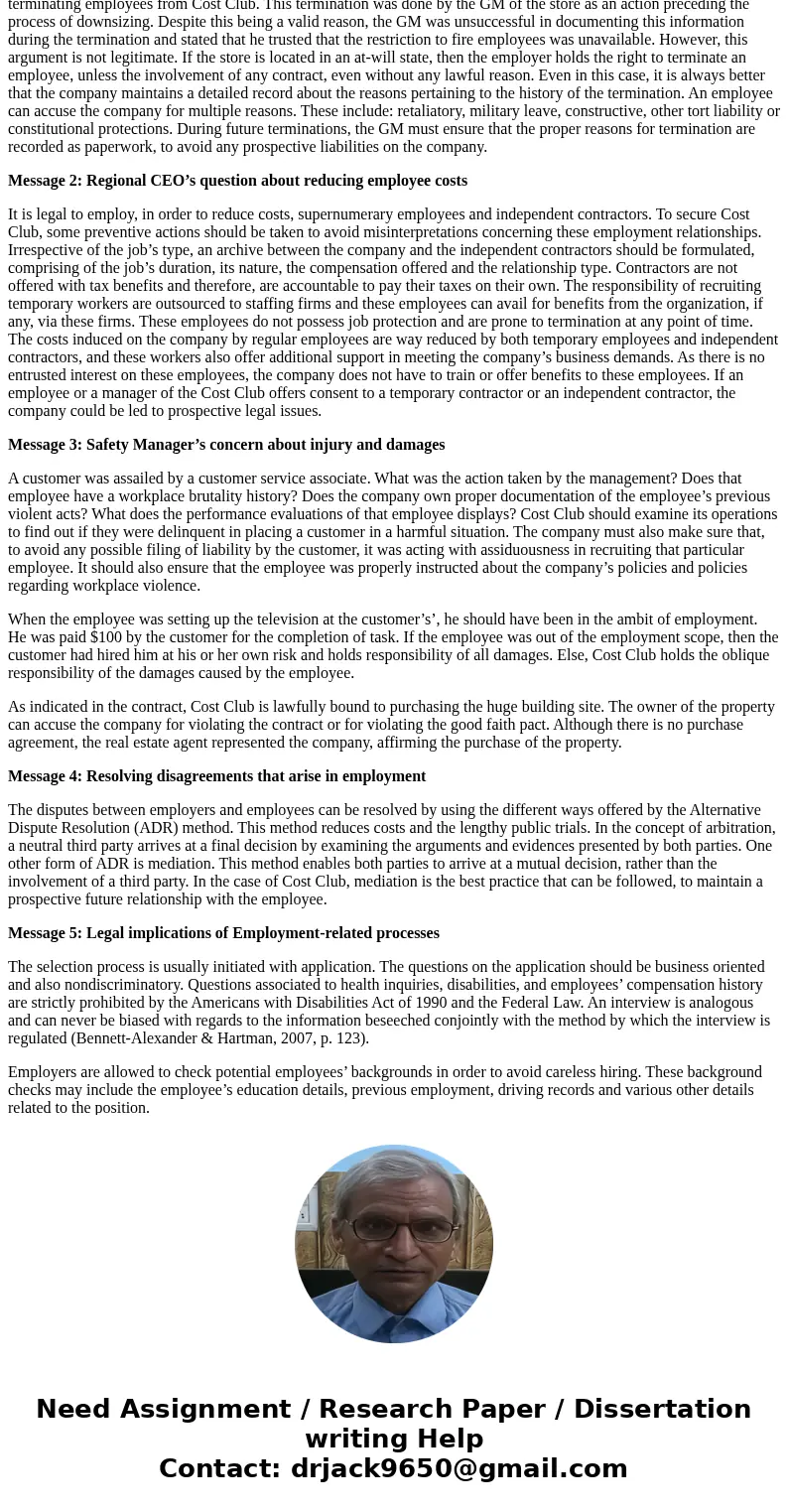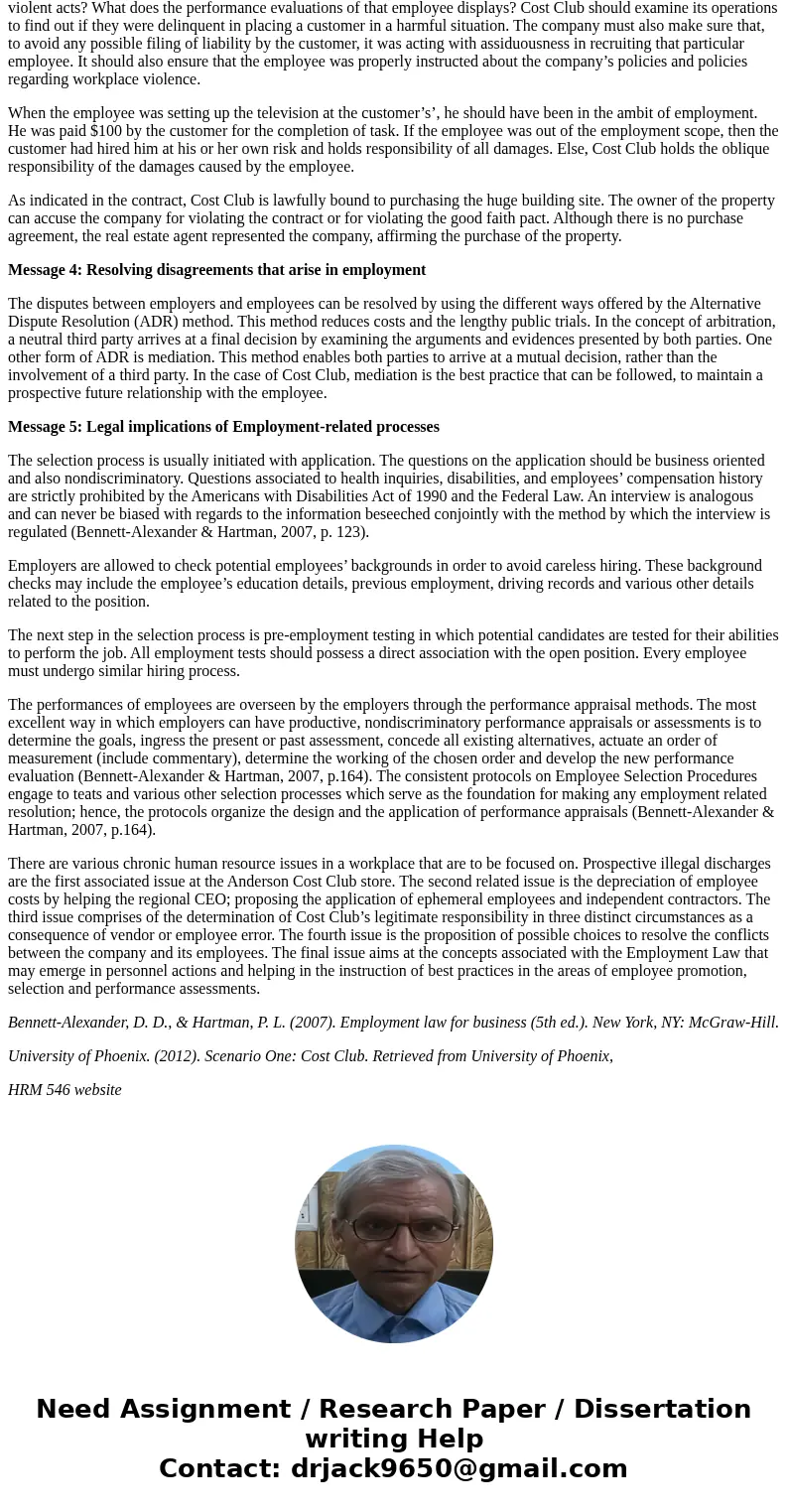Write a 1050 to 1400word memo in memo form that is fully res
Write a 1,050- to 1,400-word memo, in memo form, that is fully responsive to the scenario and its five messages from Pat. Be careful to follow the instructions presented by Pat at various points in Scenario One.
Scenario One: Cost Club
Background
Cost Club is a growing retailer, similar to Super Wal-Mart or Target. It provides discount merchandise and supermarket products in large stores located in many areas of the United States. Cost Club is administratively organized into regions, and each region is permitted to develop its own operational policies, as long as the bottom line of low cost and reasonable service to customers is maintained. There are many strong competitors to Cost Club, with some regions experiencing more competition than others.
Your Role in Cost Club
You recently have joined the Atlanta regional office of Cost Club as the Assistant Manager of Human Resources (HR) for the region. If you do well in this assignment, you may advance to the HR manager spot when your boss, Pat, moves on to another executive role in Cost Club. For memo purposes, Pat’s last name is the same as the last name of your facilitator.
Pat has explained that while the Manager’s role is to focus on long-range and integration issues involving the entire region, your role as assistant manager is to deal with HR issues that arise routinely in the workplace. Pat has forwarded you a number of e-mails that present situations referred to HR; you must look at the situations and respond to Pat in an e-mail that addresses all the forwarded e-mails. Pat apologizes for not giving you time to settle in to your new position, but says that these are significant and time-sensitive issues that have to be dealt with quickly. You immediately begin examining the forwarded messages.
Dealing with the Problems
Message 1: Discharges at the Anderson Cost Club store.
The first e-mail, with attachments, provided background on the discharges that had recently occurred at the Anderson Cost Club store, which is located in a right-to-work state. The general manager (GM) had fired two employees without giving them any reason for the discharges. When questioned, the GM at Anderson said that he wanted to downsize his workforce in his store, and because Cost Club was nonunion, there is no restriction on discharging anyone for any reason. He claimed that he did have to give a reason. Pat forwarded the information with a note saying, “The GM believes there is no restriction on the right to fire people, but we are concerned that the employees in question will file wrongful discharge lawsuits against us. If they do, we may lose the case, because we didn’t give a reason for the discharge.”
Message 2: Regional CEO’s question about reducing employee costs.
The second e-mail was sent to Pat from the Region’s Chief Executive Officer (CEO), who is looking for ways to reduce employee costs. The key comments in the memo included:
“Nearly 40% of our region’s costs are employment related. Right now, nearly 100% of our workforce are full-time or part-time employees. We have few employees who are provided by temp agencies, and we have even fewer independent contractors doing the things that have to be done for us to serve our customers. I’d like you to consider the use of temps and contractors as a way to reduce our employment costs. Will the law allow us to do that? I don’t want the lawyers involved yet—just an initial explanation. You don’t need to worry about the cost issues of the various types of workers—I just want to know what the differences are, and if we can use those other types more to do our work.”
Pat asks that you briefly explain the differences in the types of workers, discuss the extent to which we can use these types of employees, the implications that arise in employment laws, and what that means to the regional CEO’s idea.
Message 3: Safety Manager’s concern about injury and damages
The third e-mail included a memo from the safety manager for this region of Cost Club. It raised the concern about events in which Cost Club may be responsible for payment of medical or other obligations. The relevant section of the safety manager’s message is as follows:
There are a number of things that have happened—things we have not invited or condoned—that involve people linked to Cost Club. These activities worry me, because Cost Club may be held responsible in some way. Here’s the specifics:
1. A customer services associate at the Springfield store had listened to a customer yell at him for a long time, and as a result, the employee yelled “Shut up!” and slapped the customer’s cheek. We certainly didn’t condone it. We don’t think that we’re liable, because the employee did something that he has been warned not to do—touch a customer. Nevertheless, the customer has threatened to sue us and the employee.
2. An employee in the electronics department of the Hillsboro store realized that a customer buying a big television didn’t know how to set it up. He offered to go to the customer’s home and set it up for $100. While setting up the television, he not only damaged the wall, requiring about $2,000 in repairs, but also shorted out the electrical system, which will require another $4,000 in electrical work at the house. The homeowner has no electricity and has moved into a motel room, saying that we are liable for the $10,000 in total costs incurred by the employee.
3. Finally, the real estate agent who helps us identify prosperous locations for new stores in Kentucky got carried away and entered into an agreement for us to purchase a large building site at a new shopping center in Lexington. We had not signed off on the purchase yet, but the property owner passed up other offers to sign with our agent, and the owner says that we’re responsible, because the agent carried a letter that said that he was the authorized representative of Cost Club. We say that we’re not liable, because we didn’t sign off on it, but it’s another example of a problem created by employees and others.
Pat asks that you provide the wording for a brief explanation of whether Cost Club is liable in these three situations. If there is any necessary information lacking, Pat asks you to address it.
Message 4: Resolving disagreements that arise in employment
Pat mentions, in a separate memo, the interest in a project that could potentially reduce the cost of dealing with lawsuits and other problems, such as Equal Employment Opportunity Commission complaints alleging discrimination. Pat summarized the potential this way:
“We have a number of disagreements between our business and employees. Many of these are resolved between the supervisor and the employee, but if it can’t be settled there, the absence of any structured process to discuss and finalize the argument means that the employee’s only alternative is to initiate a lawsuit—something that is expensive for all concerned, and that often doesn’t resolve the matter, but actually magnifies it!
What alternatives could we use to settle any issues on the job between the company and its employees? Which processes work best, and for what types of problems? How are the alternatives the same and different? When you assemble this material, we’ll decide what to do.”
Message 5: Legal implications of Employment-related processes
Almost as an afterthought, Pat asks you to provide some general information to help in a training session that Pat has agreed to conduct. Pat said the following:
“I have been asked to conduct a training session that covers best practices in selection, promotion, and performance evaluation of employees, and how to best select employees for developmental training. The folks who have provided input have covered best practices pretty well, but I’d like to also have some perspective on the Employment Law matters that can arise in these personnel actions. Please provide me a brief summary of the important Employment Law concepts that would relate to selection, so that I can touch on the legal dimension of the issue.”
Solution
Pertaining to the administration, Cost Club is systematized into regions, and every region fosters its individual operational policies inasmuch as a moderate customer service and a low cost bottom line is perpetuated (University of Phoenix, 2012). There are various chronic human resource issues in a workplace that are to be focused on. Prospective illegal discharges are the first associated issue at the Anderson Cost Club store. The second related issue is the depreciation of employee costs by helping the regional CEO; proposing the application of ephemeral employees and independent contractors. The third issue comprises of the determination of Cost Club’s legitimate responsibility in three distinct circumstances as a consequence of vendor or employee error. The fourth issue is the proposition of possible choices to resolve the conflicts between the company and its employees. The final issue aims at the concepts associated with the Employment Law that may emerge in personnel actions and helping in the instruction of best practices in the areas of employee promotion, selection and performance assessments.
Message 1: Discharges at the Anderson Cost Club store
The state at which the Anderson Cost Club store is located is a right-to-work state, in which people own the right to determine upon joining or financially substantiating a union. This has no relationship with the reasons involved in terminating employees from Cost Club. This termination was done by the GM of the store as an action preceding the process of downsizing. Despite this being a valid reason, the GM was unsuccessful in documenting this information during the termination and stated that he trusted that the restriction to fire employees was unavailable. However, this argument is not legitimate. If the store is located in an at-will state, then the employer holds the right to terminate an employee, unless the involvement of any contract, even without any lawful reason. Even in this case, it is always better that the company maintains a detailed record about the reasons pertaining to the history of the termination. An employee can accuse the company for multiple reasons. These include: retaliatory, military leave, constructive, other tort liability or constitutional protections. During future terminations, the GM must ensure that the proper reasons for termination are recorded as paperwork, to avoid any prospective liabilities on the company.
Message 2: Regional CEO’s question about reducing employee costs
It is legal to employ, in order to reduce costs, supernumerary employees and independent contractors. To secure Cost Club, some preventive actions should be taken to avoid misinterpretations concerning these employment relationships. Irrespective of the job’s type, an archive between the company and the independent contractors should be formulated, comprising of the job’s duration, its nature, the compensation offered and the relationship type. Contractors are not offered with tax benefits and therefore, are accountable to pay their taxes on their own. The responsibility of recruiting temporary workers are outsourced to staffing firms and these employees can avail for benefits from the organization, if any, via these firms. These employees do not possess job protection and are prone to termination at any point of time. The costs induced on the company by regular employees are way reduced by both temporary employees and independent contractors, and these workers also offer additional support in meeting the company’s business demands. As there is no entrusted interest on these employees, the company does not have to train or offer benefits to these employees. If an employee or a manager of the Cost Club offers consent to a temporary contractor or an independent contractor, the company could be led to prospective legal issues.
Message 3: Safety Manager’s concern about injury and damages
A customer was assailed by a customer service associate. What was the action taken by the management? Does that employee have a workplace brutality history? Does the company own proper documentation of the employee’s previous violent acts? What does the performance evaluations of that employee displays? Cost Club should examine its operations to find out if they were delinquent in placing a customer in a harmful situation. The company must also make sure that, to avoid any possible filing of liability by the customer, it was acting with assiduousness in recruiting that particular employee. It should also ensure that the employee was properly instructed about the company’s policies and policies regarding workplace violence.
When the employee was setting up the television at the customer’s’, he should have been in the ambit of employment. He was paid $100 by the customer for the completion of task. If the employee was out of the employment scope, then the customer had hired him at his or her own risk and holds responsibility of all damages. Else, Cost Club holds the oblique responsibility of the damages caused by the employee.
As indicated in the contract, Cost Club is lawfully bound to purchasing the huge building site. The owner of the property can accuse the company for violating the contract or for violating the good faith pact. Although there is no purchase agreement, the real estate agent represented the company, affirming the purchase of the property.
Message 4: Resolving disagreements that arise in employment
The disputes between employers and employees can be resolved by using the different ways offered by the Alternative Dispute Resolution (ADR) method. This method reduces costs and the lengthy public trials. In the concept of arbitration, a neutral third party arrives at a final decision by examining the arguments and evidences presented by both parties. One other form of ADR is mediation. This method enables both parties to arrive at a mutual decision, rather than the involvement of a third party. In the case of Cost Club, mediation is the best practice that can be followed, to maintain a prospective future relationship with the employee.
Message 5: Legal implications of Employment-related processes
The selection process is usually initiated with application. The questions on the application should be business oriented and also nondiscriminatory. Questions associated to health inquiries, disabilities, and employees’ compensation history are strictly prohibited by the Americans with Disabilities Act of 1990 and the Federal Law. An interview is analogous and can never be biased with regards to the information beseeched conjointly with the method by which the interview is regulated (Bennett-Alexander & Hartman, 2007, p. 123).
Employers are allowed to check potential employees’ backgrounds in order to avoid careless hiring. These background checks may include the employee’s education details, previous employment, driving records and various other details related to the position.
The next step in the selection process is pre-employment testing in which potential candidates are tested for their abilities to perform the job. All employment tests should possess a direct association with the open position. Every employee must undergo similar hiring process.
The performances of employees are overseen by the employers through the performance appraisal methods. The most excellent way in which employers can have productive, nondiscriminatory performance appraisals or assessments is to determine the goals, ingress the present or past assessment, concede all existing alternatives, actuate an order of measurement (include commentary), determine the working of the chosen order and develop the new performance evaluation (Bennett-Alexander & Hartman, 2007, p.164). The consistent protocols on Employee Selection Procedures engage to teats and various other selection processes which serve as the foundation for making any employment related resolution; hence, the protocols organize the design and the application of performance appraisals (Bennett-Alexander & Hartman, 2007, p.164).
There are various chronic human resource issues in a workplace that are to be focused on. Prospective illegal discharges are the first associated issue at the Anderson Cost Club store. The second related issue is the depreciation of employee costs by helping the regional CEO; proposing the application of ephemeral employees and independent contractors. The third issue comprises of the determination of Cost Club’s legitimate responsibility in three distinct circumstances as a consequence of vendor or employee error. The fourth issue is the proposition of possible choices to resolve the conflicts between the company and its employees. The final issue aims at the concepts associated with the Employment Law that may emerge in personnel actions and helping in the instruction of best practices in the areas of employee promotion, selection and performance assessments.
Bennett-Alexander, D. D., & Hartman, P. L. (2007). Employment law for business (5th ed.). New York, NY: McGraw-Hill.
University of Phoenix. (2012). Scenario One: Cost Club. Retrieved from University of Phoenix,
HRM 546 website




 Homework Sourse
Homework Sourse